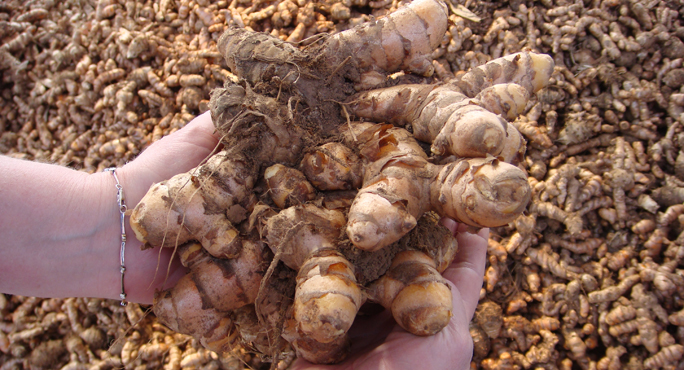Turmeric. Photo courtesy Medicine Hunter
An estimated 50 million Americans suffer from chronic pain, according to the American Pain Foundation. That’s a lot of pain. And that adds up to a lot of drug use, notably the category called NSAID’s, or non-steroidal anti-inflammatory drugs. Ibuprofen (Advil, Motrin), naproxen (Aleve, Naprosyn), diclofenac (Voltaren) and Celebrex belong to this class of drugs. These drugs are designed to inhibit activity of what is known as the COX2 enzyme, a major factor in pain. This natural enzyme is created in all of us, and is responsible for the production of some of the agents called prostaglandins, which trigger pain and inflammation.
The role of inflammation in pain is pretty straightforward. Any of a variety of insults can cause inflammation in the tissues of our bodies. External insults like burns, bites, scrapes, stings, cuts and bruises cause skin tissue to swell as protective fluids pour into damaged tissue between cells. Nerves may also be directly hurt. All of this activity is accompanied by pain. This is also the case with internal insults that may be diet-related or the result of wear and tear. Aging joints and ligaments can become occasionally or chronically inflamed, resulting in pain. Inflammation is now recognized as a key factor in virtually all chronic and degenerative diseases, including arthritis, heart disease, asthma, neurodegeneration, cancer, and kidney and bowel diseases. The idea behind anti-inflammatory drugs is simple. Stop the inflammation; stop the pain.
The NSAID’s are COX-2 inhibitors. They do accomplish this, but along the way they can also cause liver and kidney damage, and increase the risk of heart attack and stroke. A recently published study reveals even greater risks to these drugs. In the study Danish researchers found that use of NSAID’s among heart attack survivors greatly increased their risk of a repeat heart attack. This risk persisted even six months after the heart attack, and even if the use of the drugs was brief. Translation: for those who have had a heart attack or stroke, the NSAID’s pose a real danger.
Meanwhile, a recent study of acetaminophen (Tylenol) showed that those who take the drug are at an increased risk of some blood cancers. Acetaminophen use is also the leading cause of drug-induced liver failure in the United States. Though acetaminophen is not an NSAID, it poses significant health hazards nonetheless.
Hippocrates said “first of all do no harm.” This should be the guided credo of all the health arts,from pharmacy to surgery. Medicines should heal not hurt, and promote life not take it away. In part due to disappointment with drugs, and in part due to a belief that natural remedies are safer than most pharmaceuticals, many people seek natural remedies to alleviate pain.
Hippocrates also said “let your food be your medicine.” One of the very most effective and potent natural anti-inflammatory agents is curcumin, derived from turmeric root. Turmeric is a yellow spice native to Asia, widely enjoyed as both a food and a dye. Turmeric is the yellow in curry powder, and curcumin is a resinous compound found in turmeric root. Extensively well studied for its anti-inflammatory powers, curcumin is scientifically proven to be highly effective at relieving pain, and very safe. Like the NSAID’s, curcumin inhibits COX2. But unlike the NSAID’s, it does not do so selectively. Instead, curcumin also affects the activity of other key factors in inflammation, including NF-kappaB, PPAR Gamma transcription factors, and 5-LOX. By inhibiting the activity of all these aspects of inflammation, curcumin delivers far superior anti-inflammatory and pain-relieving activity than most drugs.
Ginger root, another common spice, also contains a number of scientifically proven pain relieving agents. Ginger contains a protein-digesting enzyme called zingibain, which appears to relieve arthritis pain by reducing inflammation. In fact, the anti-inflammatory activity of ginger compares favorably with aspirin. Ginger root is also rich in two groups of compounds known as the shaogals and gingerols. These compounds are powerfully antioxidant, thus helping to prevent cells from premature destruction due to exposure to environmental toxins and by-products of metabolism. Even more, these compounds are potent anti-inflammatory agents, and are proven to relieve inflammation throughout the body. Given that oxidation and inflammation are part and parcel of all chronic degenerative diseases, ginger can play a key role in disease risk reduction.
Many plants, including the Amazon bark cats’ claw and the common spice rosemary, also demonstrate powerful anti-inflammatory, pain-relieving properties. And in toxicity studies, the anti-inflammatory plants demonstrate great safety. Many hundreds of plants contain well known anti-inflammatory agents. Hops, for example, an herb used in beer brewing, contains a group of compounds called the humulones, which are being studied for their significant pain-relieving properties.
Among the many plant-based anti-inflammatory products out there, I recommend Curamin, the curcumin-based pain reliever from EuroPharma, and Zyflamend, the ginger and turmeric-based anti-inflammatory from New Chapter. Both of these products work, and the ingredients in them actually contribute to overall health by enhancing immune function, increasing cardiovascular protection, and helping to inhibit the aging process of cells by their antioxidant activity. They are available online and at Whole Foods and other natural retailers.
It is sad when drugs that are commonly used are shown to pose great dangers to health. This is antithetical to their purpose. But the science of plant-based medicines is significantly advanced, and we now have products available to us that will reduce or eliminate pain without being hazardous to health. This is a good thing.


